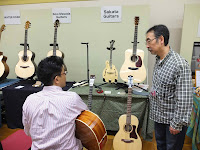 |
| Jeffrey and I |
With great anticipation, I have attended the Tokyo Handcrafted Guitar Show from 18 to 19 May 2013. Once again Jeffrey Yong has invited me to attend the show. Japan is basically a closed market to foreign products. Jeffrey's entry to this guitar show was due to his participation in Sound Messe Osaka in September 2012.
Weblink: http://handcraftguitar.jp/ex.html
In summary, these are some basic fact about the Tokyo Handcrafted Guitar show,
1. This is the 7th show in Tokyo
2. Tokyo is known to have the highest concentration of guitar collectors
3. The exhibitors are mostly guitar makers instead of retailers
4. It was held at 8th floor Sumida Ward, Marui joint development building, in the heart of town.
5. There were about 100 exhibitors
As I have only attended one other guitar show in Japan, in a remote way, Sound Messe Osaka in September 2012 has set the precedence for benchmarking. The Tokyo Handcrafted Guitar Show featured primarily handcrafted guitars and less retailers. It wasn't unexpected to see a smaller show when contrasted with the Osaka one. However it was a longer history.
The exhibition is located on 8th floor Sumida Ward, Marui joint development building. Upon entering the hall, immediately one can tell that the hall was well utilized and maintained for years. The set up of the exhibition was logically aligned to the interior shape of the exhibition hall, which is rectangle. The space was adequately optimized by the tables arrangement, in Japan style indeed. Each exhibitor was given a label for identity purpose. There was little restriction to creativity in product display. The exhibitors hesitated not in exercising initiatives to decorate their booths and some went to great length to make sure they were head turners.
Luthiers is a respectable trade in Japan. Judging from the number of young luthiers I met in the show, this trade is probably sought after. Unlike Singaporeans who predominantly seek for professions that give greater monetary rewards over intrinsic values. In guitar design and building principles, Western made acoustic guitars have profound influences on Japanese guitar makers. The are pretty convinced about the choice of woods that can be made into guitars. While there are many trees that are native to Japan, the luthiers were not readily keen to utilize them. The most commonly used combination was German Spruce as guitar top plate and Jacaranda (Rosewood) as back and sides. Most luthiers were convinced that this combination will yield the best tonal qualities. This belief is probably exacerbated by the sales of such guitar, which is likely reinforced by to the great numbers of such guitar in the market as well.
It is perfectly normal for luthiers to seek for good quality wood to make their guitars. However wood isn't perfect to begin with. Personally I think that there is no one piece of wood that is better than another unless it is a rotten piece. Likewise we can't regard someone to be a better person and another to be less because nobody is perfect to start with, and each person possess his or her unique personalities, which is analogous to wood. I find it strange and inappropriate to discriminate wood and such practice is pervasive in commercial trading of woods. By by my stated beliefs, I don't mean we can make guitars with just about any wood. Practical factors should be considered which includes weight, toughness, density, workability, aesthetic, etc. We should take these factors into account instead of fixating on certain wood species and ignore the rest.
While the Tokyo Handcrafted Show wasn't as crowded and huge as those I have attended, just by being in the show was great for me. Above all, the most valuable gain was meeting luthiers and making more friends.
Pictures galore time! More pictures can be viewed in my FB photo albums. Just click here.
Eve of Tokyo Handcrafted Guitar Show
Tokyo Handcrafted Guitar Show
Shopping in Tokyo
-End of Article-










































































































for the last 3 pics of the Yamaha guitars, what's that they put in the soundhole?
ReplyDeleteHi Arthur, those things inserted into the soundholes are humidifiers. Relative humidity in Japan is general low and guitars usually face over-drying issues. The humidifiers help to compensate the lack in moisture. Hope it helps.
ReplyDelete